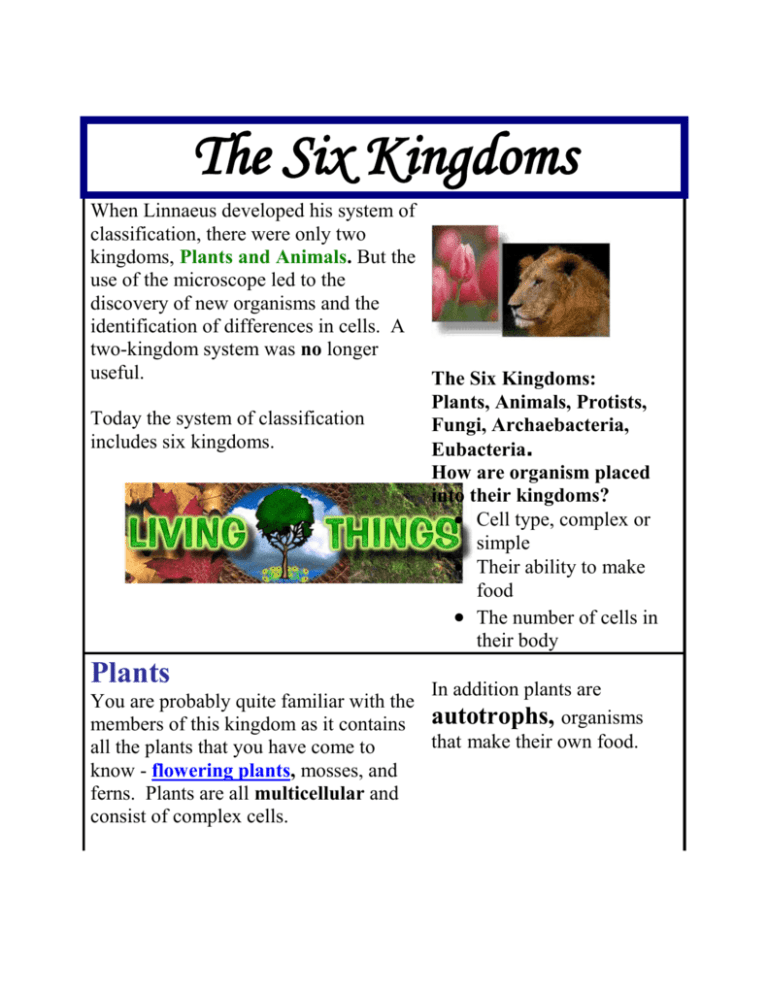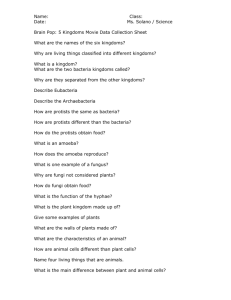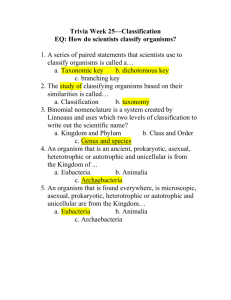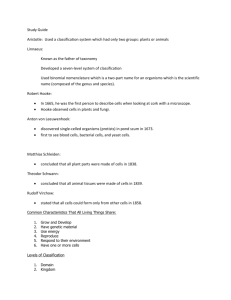Six Kingdoms of Life: An Introduction
advertisement

The Six Kingdoms When Linnaeus developed his system of classification, there were only two kingdoms, Plants and Animals. But the use of the microscope led to the discovery of new organisms and the identification of differences in cells. A two-kingdom system was no longer useful. The Six Kingdoms: Plants, Animals, Protists, Today the system of classification Fungi, Archaebacteria, includes six kingdoms. Eubacteria. How are organism placed into their kingdoms? Cell type, complex or simple Their ability to make food The number of cells in their body Plants In addition plants are You are probably quite familiar with the members of this kingdom as it contains autotrophs, organisms that make their own food. all the plants that you have come to know - flowering plants, mosses, and ferns. Plants are all multicellular and consist of complex cells. With over 250,000 species, the plant kingdom is the second largest kingdom. Plant species range from the tiny green mosses to giant trees. Without plants, life on Earth would not exist! Plants feed almost all the heterotrophs (organisms that eat other organisms) on Earth. Wow! Animals The animal kingdom is the largest kingdom with over 1 million known species. All animals consist of many complex cells. They are also heterotrophs. Sumatran Tiger - Kingdom: Animalia, Members of the animal kingdom are found in the most diverse environments in the Phylum, Chordata, Class Mammalia, Order Carnivora, Family Felidae, Genus Pathera, Species tigris world. Archaebacteria In 1983, scientists tool samples from a spot deep in the Pacific Ocean where hot gases and molten rock boiled into the ocean form the Earth’s interior. To their surprise they discovered unicellular (one cell) organisms in the samples. These organisms are today classified in the kingdom, Archaebacteria. Finding Archaebacteria: The hot springs of Yellowstone Archaebacteria are found in extreme environments such as hot boiling water and thermal vents under conditions with no oxygen or highly acid environments. National Park, USA, were among the first places Archaebacteria were discovered. The biologists pictured above are immersing microscope slides in the boiling pool onto which some archaebacteria might be captured for study. Eubacteria Like archaebacteria, eubacteria are complex and single celled. Most bacteria are in the EUBACTERIA kingdom. They are the kinds found everywhere and are the ones people are most familiar with. Eubacteria are classified in their own kingdom because their chemical makeup is different. Fungi Mushrooms, mold and mildew are all examples of organisms in the kingdom fungi. Most fungi are multicellular and consists of many complex cells. Fun Facts about Fungi Most eubacteria are helpful. Some produce vitamins and foods like yogurt. However, these eubacteria, Streptococci pictured above, can give you strep throat! Fungi are organisms that biologists once confused with plants, however, unlike plants, fungi cannot make their own food. Most obtain their food from parts of plants that are decaying in the soil. Some fungi taste great and others can kill you! Protists Slime molds and algae are protists. Sometimes they are called the odds and ends kingdom because its members are so different from one another. Protists include all microscopic organisms that are not bacteria, not animals, not plants and not fungi. Most protists are unicellular. You may be wondering why those protists are not classified in the Archaebacteria or Eubacteria kingdoms. It is because, unlike bacteria, protists are complex cells. These delicate looking diatoms are classified in the protist kingdom.











